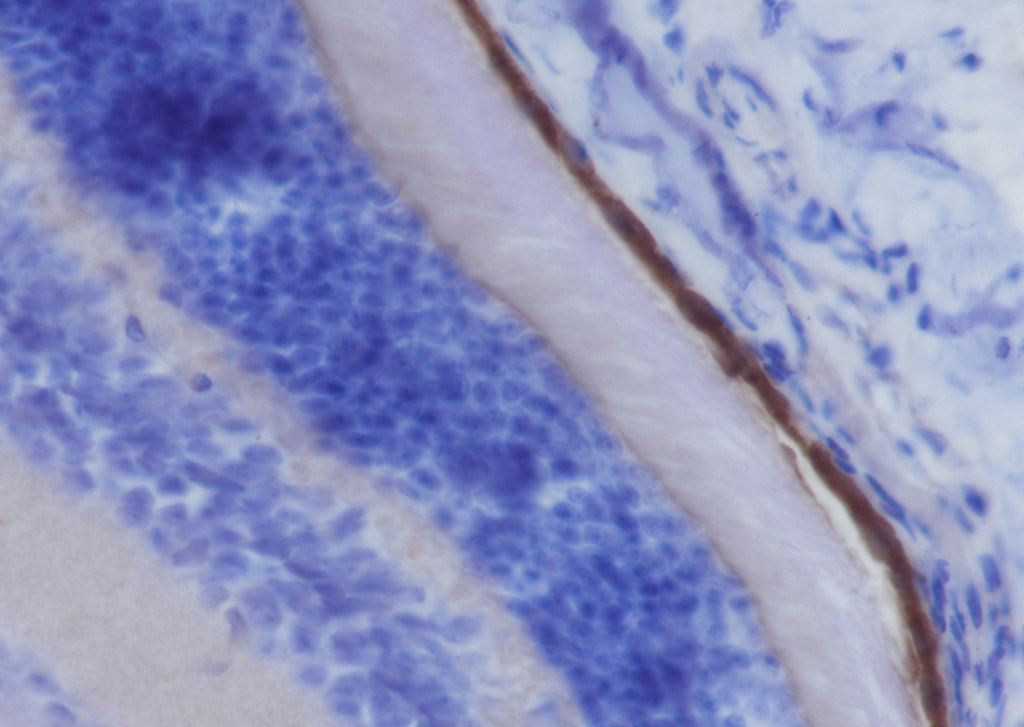
Rabbit Anti-RPE65 antibody
All-trans-retinyl-palmitate hydrolase; LCA 2; LCA2; Leber congenital amaurosis; mRPE 65; mRPE65; p63; rd 12; rd12; Retinal pigment epithelium specific 61 kDa protein; Retinal pigment epithelium specific 65 kDa protein; Retinal pigment epithelium specific
View History [Clear]
Details
Product Name RPE65 Chinese Name 视网膜色素epithelial cells特异性蛋白65抗体 Alias All-trans-retinyl-palmitate hydrolase; LCA 2; LCA2; Leber congenital amaurosis; mRPE 65; mRPE65; p63; rd 12; rd12; Retinal pigment epithelium specific 61 kDa protein; Retinal pigment epithelium specific 65 kDa protein; Retinal pigment epithelium specific protein; Retinal pigment epithelium specific protein 65kDa; Retinal pigment epithelium-specific 65 kDa protein; Retinitis pigmentosa 20; Retinoid isomerohydrolase; RP 20; RP20; RPE 65; RPE65; RPE65_HUMAN; sRPE 65; sRPE65. Research Area Tumour Neurobiology Signal transduction Immunogen Species Rabbit Clonality Polyclonal React Species Mouse, Applications WB=1:500-2000 IHC-P=1:1000-4000 (Paraffin sections need antigen repair)
not yet tested in other applications.
optimal dilutions/concentrations should be determined by the end user.Theoretical molecular weight 59kDa Cellular localization cytoplasmic The cell membrane Form Liquid Concentration 1mg/ml immunogen KLH conjugated synthetic peptide derived from mouse RPE65 Lsotype IgG Purification affinity purified by Protein A Buffer Solution 0.01M TBS(pH7.4) with 1% BSA, 0.03% Proclin300 and 50% Glycerol. Storage Shipped at 4℃. Store at -20 °C for one year. Avoid repeated freeze/thaw cycles. Attention This product as supplied is intended for research use only, not for use in human, therapeutic or diagnostic applications. PubMed PubMed Product Detail The retinal pigment epithelium (RPE) is a monolayer simple epithelium in proximity to the outer surface of the retinal photoreceptor cells. Retinal pigment epithelium-specific protein (RPE65) is a 65 kDa protein belonging to the β-carotene dioxygenase family. This protein is important in 11-cis retinal production as well as in visual pigment regeneration. RPE65 is attached to the membrane by a lipid anchor when palmitoylated (membrane form) and soluble when unpalmitoylated. The soluble form of the protein binds vitamin A. Defects in RPE65 causes autosomal dominant retinitis pigmentosa and/or Leber congenital amaurosis type 2.
Function:
Plays important roles in the production of 11-cis retinal and in visual pigment regeneration. The soluble form binds vitamin A (all-trans-retinol), making it available for LRAT processing to all-trans-retinyl ester. The membrane form, palmitoylated by LRAT, binds all-trans-retinyl esters, making them available for IMH (isomerohydrolase) processing to all-cis-retinol. The soluble form is regenerated by transferring its palmitoyl groups onto 11-cis-retinol, a reaction catalyzed by LRAT. The enzymatic activity is linearly dependent of the expression levels and membrane association.
Subunit:
Interacts with MYO7A; this mediates light-dependent intracellular transport of RPE65.
Subcellular Location:
Cytoplasm. Cell membrane. Attached to the membrane by a lipid anchor when palmitoylated (membrane form), soluble when unpalmitoylated.
Tissue Specificity:
Retinal pigment epithelium specific.
Post-translational modifications:
Palmitoylation by LRAT regulates ligand binding specificity; the palmitoylated form (membrane form) specifically binds all-trans-retinyl-palmitate, while the soluble unpalmitoylated form binds all-trans-retinol (vitamin A).
DISEASE:
Defects in RPE65 are the cause of Leber congenital amaurosis type 2 (LCA2) [MIM:204100]. LCA designates a clinically and genetically heterogeneous group of childhood retinal degenerations, generally inherited in an autosomal recessive manner. Affected infants have little or no retinal photoreceptor function as tested by electroretinography. LCA represents the most common genetic cause of congenital visual impairment in infants and children.
Similarity:
Belongs to the carotenoid oxygenase family.
SWISS:
Q91ZQ5
Gene ID:
19892
Database links:Entrez Gene: 6121 Human
Entrez Gene: 19892 Mouse
Omim: 180069 Human
SwissProt: Q9YGX2 Chicken
SwissProt: Q16518 Human
SwissProt: Q91ZQ5 Mouse
Unigene: 2133 Human
Unigene: 131708 Mouse
Unigene: 76724 Rat
Product Picture
Section type: Formalin fixed & Paraffin -embedded section
Retrieval method: High temperature and high pressure
Retrieval buffer: Tris/EDTA buffer, pH 9.0 Primary ab dilution: 1:4000
Primary ab incubation condition: 1 hour at room temperature
Counter stain: Hematoxylin
Comment: Color brown is the positive signal for SLM-60224R
References (0)
No References
Bought notes(bought amounts latest0)
No one bought this product
User Comment(Total0User Comment Num)
- No comment



 +86 571 56623320
+86 571 56623320
 +86 18668110335
+86 18668110335

